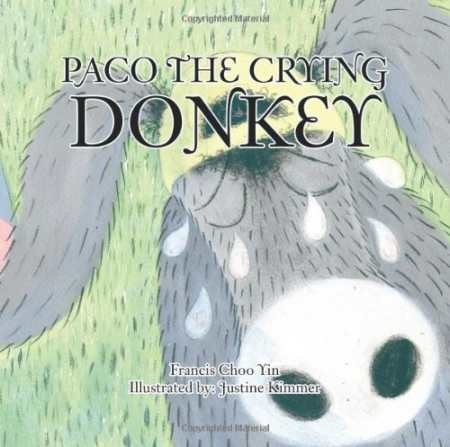
Paco the Crying Donkey
The sing-along narrative and Caribbean-style illustrations encourage even shy participants to join in the fun in this story/one-act play.
Born and raised in Trinidad, author Francis Choo Yin has fond memories of the popular calypso songs of his youth. Drawing inspiration from a traditional calypso about a donkey, and borrowing names for his human characters from the lyrics of another well-known song, he offers his story of Paco the Crying Donkey, a moral tale for young children. Choo Yin also provides a website address for those who would like to download the tale as a fun, easy-to-perform, one-act children’s play that promises a part for every child who wants to join the cast.
Set in a magical kingdom to which working animals retire when their days of toil are over, the story features a variety of creatures, large and small. Bright and whimsical illustrations by artist Justine Kimmer enrich the delightfully fanciful tone of the story with clever depictions of horses, monkeys, ducks, and an elephant. Kimmer’s joyful pictures of the animals in formal wear are simply charming. Moving beyond the book, the play allows for an even broader menagerie, for virtually any working animal can take part.
Oswell, a “proud, brave rooster,” rules the kingdom. The day Paco the donkey arrives, Oswell announces an upcoming ball, the largest the animals have ever held, with the caveat that each attendee must bring a friend. “Poor, poor Paco,” new to the kingdom, has no friends there, and his terrible crying begins. “Eeey,,ore, eeey,,ore, eeey,,ore!” he cries, drowning out even the excited cheering of the other animals.
Four human girls who were kind to Paco during his tireless days spent working in a mill appear, comforting Paco and singing a calypso to make him feel better. One of the girls summons the “queen of the happy spirits,” who arrives and chastises Oswell and the others for making Paco feel left out. Admitting the error of his ways, Oswell welcomes Paco into the group, and the donkey soon has more friends than ever before.
Paco the Crying Donkey echoes the rhythmic calypso vibe the author so clearly recalls from his youth, and Kimmer’s illustrations contribute the rich, vivid color so closely associated with the Caribbean locale. Children will love braying along with “Poor Paco” as his cries of “Eeey,,ore, eeey,,ore” change from sadness to joy. Calypso-style lyrics for “Don’t cry donkey, donkey don’t cry” encourage a happy sing-along, perfect for a rollicking story hour at home or at school. Teachers seeking a very inclusive play for their young students to perform should check Choo Yin’s website. There are parts not only for plenty of “stars” but also for the shiest of reluctant participants.
Upbeat and instructive, with an uplifting, happy ending, Paco the Crying Donkey will have even adults singing along.
Reviewed by
Cheryl Hibbard
Disclosure: This article is not an endorsement, but a review. The publisher of this book provided free copies of the book and paid a small fee to have their book reviewed by a professional reviewer. Foreword Reviews and Clarion Reviews make no guarantee that the publisher will receive a positive review. Foreword Magazine, Inc. is disclosing this in accordance with the Federal Trade Commission’s 16 CFR, Part 255.
